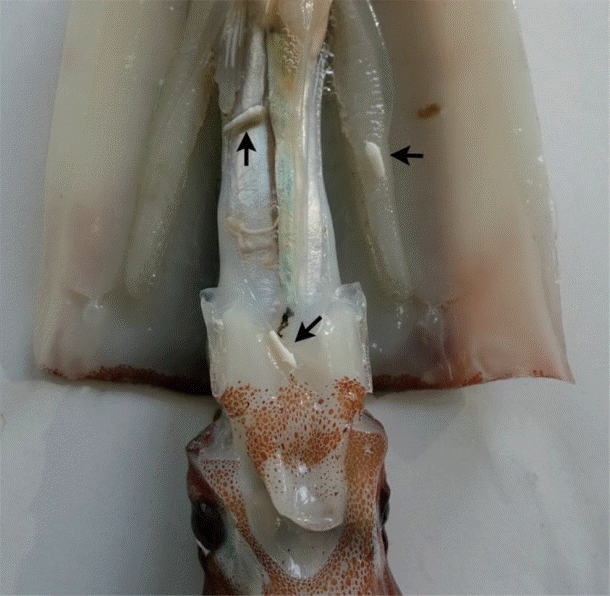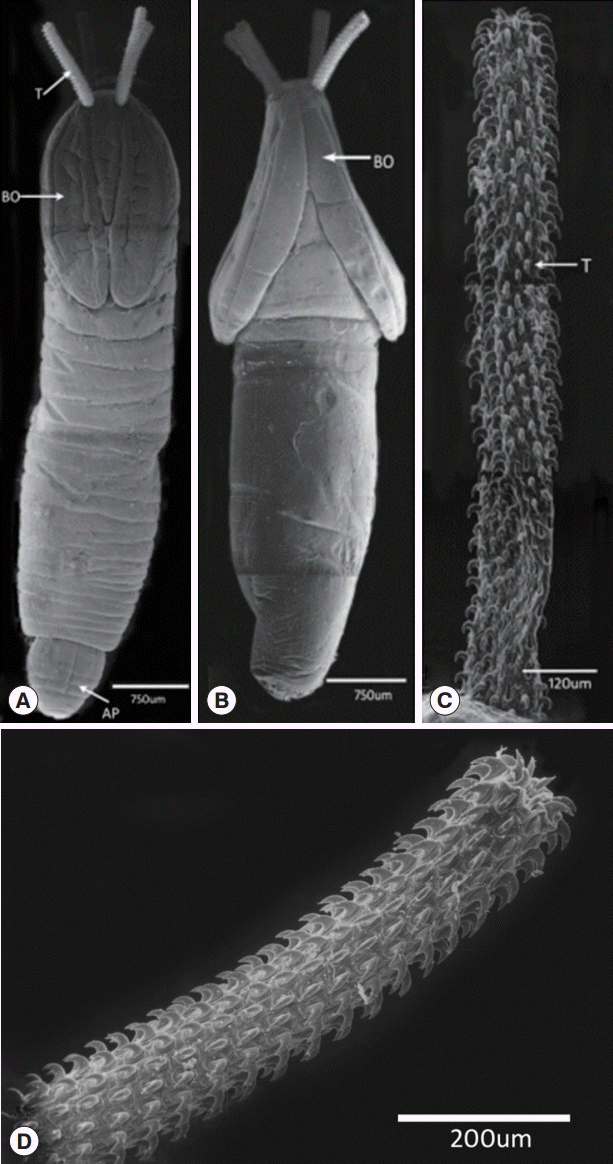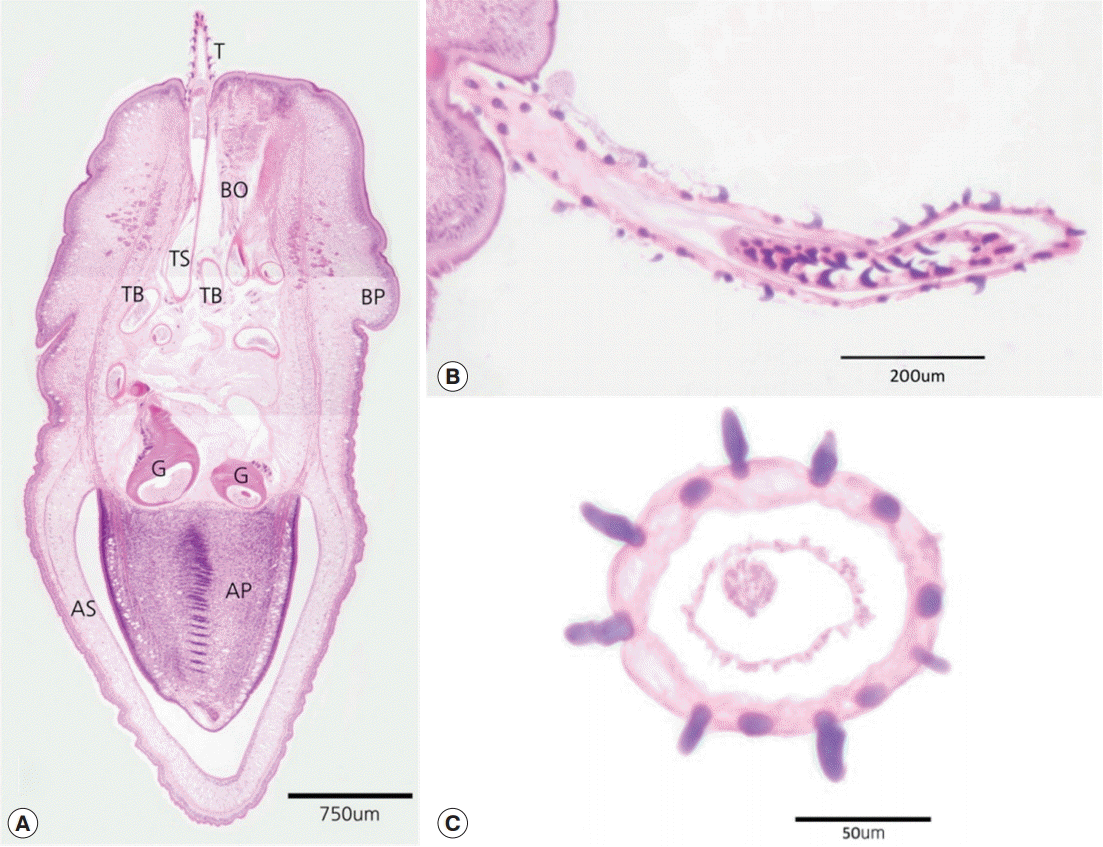Abstract
A visceral helminth of the squid, Todarodes pacificus, is reported from the East Sea, the Republic of Korea. Total 39 squid samples were purchased from a fish market in Jumunjin-eup, Gangneung-si (City) from August 2014 to July 2015 and were examined for helminth parasites with naked eyes and under a stereomicroscope after opening the abdominal cavity with a pair of scissors. Whitish larval worms were mainly found in the stomach and abdominal cavity of the squid. They were detected in 25 (64.1%) out of 39 squids examined, and the infection density was 7 larvae per infected squid. Spatula-shaped larvae were 8.2×2.0 mm in average size, round to slightly flattened anteriorly, with round hatching posteriorly, and had characteristic 4 tentacles with numerous hooklets in the scolex. The larvae were identified as the plerocercoid stage of Nybelinia surmenicola by their morphological features. This finding represents a new host record and the first report of N. surmenicola infection in T. pacificus squids from the east coast of Korea.
-
Key words: Nybelinia surmenicola, Todarodes pacificus, new record, plerocercoid, squid
The trypanorhynchid cestodes (Order Trypanorhyncha) are one of the main groups of parasites that infect fish and cephalopods. They go through 3-4 host life cycles before reaching their final host [
1]. Adult trypanorhynchids are typically found in the stomach and intestine of sharks and rays, while their larval forms infect a wide variety of marine invertebrates and teleosts [
2,
3]. They are characterized by a scolex bearing 2 or 4 bothria [
4] and a tentacular apparatus consisting of 4 retractile tentacles capped with hooks as extensions of the tentacle sheaths [
5]. A total of 254 species are currently recognized in the trypanorhynchid cestode group [
6]. The important morphological characteristics, i.e., the shape of scolex, number of bothria, tentacular armature, genital organs, and bothrial pits, are considered as major differential points in the taxonomic study of this group [
7]. In the present study, we record the plerocercoid larvae of
Nybelinia surmenicola (Cestoda: Tentacularidae) detected in the squid,
Todarodes pacificus, from East Sea, the Republic of Korea.
A total of 39 squids were purchased from a fish market in Jumunjin-eup, Gangneung-si (City), Korea from August 2014 to July 2015. The squids were transported to the laboratory, and plerocercoid larvae were obtained from the stomach mucosa, external stomach wall, and body cavities of the squids using a stereoscopic dissecting microscope. They were first observed alive in saline solution (0.9% NaCl), then fixed in formalin saline (4% buffered formalin in 1% saline) for 24 hr. They were subsequently transferred to 70% ethanol. Additional glutaraldehyde-fixed specimens were prepared for SEM via an ethanol dehydration series. The length and width of the parasites were measured. The parasites were identified by the shape and number of hooks on their probosces using light microscopy and scanning electron microscopy (Field Emission Scanning Electron Microscope, FEI, Inspect F, Brno, Czech Republic). Also, tissue specimens were fixed in 10% neutral formalin for routine histological examinations. The fixed samples were washed in tap water overnight and exposed to increasing concentrations of ethanol (70%, 80%, 90%, and 100%), rinsed with xylene, and embedded in paraffin. Worm sections in 5 μm thickness were mounted on slides and stained with hematoxylin and eosin (H-E). Classification of trypanorhynchids in the present study was done according to Palm and Walter [
5], Bray [
8], and WoRMS [
9]. A specimen has been deposited in the Department of Environmental Medical Biology, College of Medicine, Catholic Kwandong University.
Of the 39 squid samples examined, 25 (64.1%) were infected with the plerocercoid larvae of
N. surmenicola of the family Tentaculariidae, order Trypanorhyncha. On average, we found 2 larval parasites attached to the stomach mucosa, 3 attached to the external stomach wall, and 2 free in the body cavity (
Fig. 1). Seasonal population dynamics showed the highest abundance from May through August. The plerocercoid larvae are pyriform, rounded to slightly flattened anteriorly, with round hatching posteriorly. The larvae have 4 tentacles at the apical end of the scolex (
Fig. 2A,
B). Each larva is 8.2±0.3 mm long and 2.0±0.2 mm wide, white, and spatula-shaped. The tentacle is armed with hooks that are uniform in size and spirally arranged at regular intervals; the hooks act as anchors (
Fig. 2C). The scolices are subcylindrical, 3.13-3.45 (av. 3.3) mm long. The bothridia are broad, shaped like right triangles, and 2.03-2.45 (av. 2.2) mm long. The appendices are 0.70-0.75 (av. 0.72) mm long. The tentacles are 0.75-1.08 (av. 0.87) mm long and 0.12-0.14 (av. 0.12) mm wide, and the microtriches are 0.04 mm long and bent (
Fig. 2D). Histological examinations of the specimens revealed the characteristic shape of cestodal larvae (
Fig. 3). The tentacular armatures of the scolex are connected to 4 bulbs.
Parasites belonging to the trypanorhynchid genus
Nybelinia are widely spread among 22 species of ommastrephid squids in the worlds [
10]. In the original description of
N. surmenicola, Okada (in Dollfus [
11]) illustrated a strongly contracted post larva found in the squid
T. pacificus (Steenstrup, 1880), but drew only the basal part of the tentacles. In this study, a different type of trypanorhynchid larvae was found. The present finding in
T. pacificus represents a new host record in Korea. This parasite is not infectious to humans and is harmless in food. However, in rare cases, the larvae stick in the throat of humans who eat uncooked squids; they can be readily removed with forceps [
12]. Saito et al. [
13] reported that a domestic cat in Japan vomited 2 infective larval forms of tetrarynchoid cestode.
N. surmenicola has been found in various intermediate teleost and cephalopod hosts [
14-
16].
N. surmenicola utilizes krills (
Euphausia pacifica) as the first intermediate host, fish as a paratenic host, and salmon shark (
Lamna ditropis) as the definitive host [
17,
18]. Rasero et al. [
19] surmised that squids are probably infected by larval cestodes via ingestion of small bony fish of the species
Conger conger,
Trachurus trachurus, and
Lophius piscatorius. Chu [
20] reported
Nybelinia lingualis in
Theragra chalcogramma from Korea. Our finding represents the first report of plerocercoids of
N. surmenicola in squids from the East Sea of Korea.
Notes
-
We have no conflict of interest related to this work.
This program was supported by the Ministry of Environment (MOE), the Republic of Korea as “Advanced Technology Program for Environmental Industry”. This work was also supported by research fund of Catholic Kwandong University (CKURF-201601670001).
Fig. 1.Plerocercoids attached to a squid, Todarodes pacificus.

Fig. 2.Scanning electron micrographs of a plerocercoid of Nybelinia surmenicola found in Todarodes pacificus. (A) A whole body with 2 bothridia (BO), 4 tentacles (T), and an appendix (AP). (B) Lateral view of the whole body. (C) Tentacles and hook profiles (T). (D) Enlargement of tentacles with hooks.

Fig. 3.A photomicrograph of a plerocercoid of Nybelinia surmenicola. (A) Cross section. (B) Longitudinal section. (C) Cross section of the tentacle. AP, appendix; AS, appendix sheath; BO, bothria; BP, bothridial pit; G, gut; TB, tentacle bulb; T, tentacle; TS, tentacle sheath.

References
- 1. Palm HW. Trypanorhyncha cestodes of commercial fishes from northeast Brazilian coastal waters. Mem Instit Oswaldo Cruz (Rio de Janeiro) 1997;92:69-79.
- 2. Palm HW. The concept of cumulative parasite evolution in marine fish parasites. In Proceedings of the IVth International Workshop on Theoretical and Marine Parasitology, AtlantNIRO, Kaliningrad, 21-26 May 2007, pp 164-170.
- 3. Al-Zubaidy AB, Mhaisen FT. Larval tapeworms (Cestoda: Trypanorhyncha) from some red sea fishes, Yemen. Mesopotamian J Mar Sci 2011;26:1-14.
- 4. Jones MK, Beveridge I, Campbell RA, Palm HW. Terminology of the sucker-like organs of the scolex of trypanorhynch cestodes. Syst Parasitol 2004;59:121-126.
- 5. Palm HW, Walter T. Tentaculariid cestodes (Trypanorhyncha) from the museum national d’Histoire naturelle, Paris. Zoosystema 2000;22:641-666.
- 6. Palm HW. The Trypanorhyncha Diesing, 1863. Bogor. PKSPLIPB Press. 2004, p 710.
- 7. Campbell RA, Beveridge I. Order Trypanorhyncha Diesing, 1863. In Khalil LF, Jones A, Bray RA eds, Keys to the Cestode Parasites of Vertebrates. Wallingford, UK. Commonwealth Agricultural Bureau International. 1994, pp 51-148.
- 8. Bray RA. Cestoda. In Costello MJ et al. eds, European register of marine species: a check-list of the marine species in Europe and a bibliography of guides to their identification. Collection Patrimoines Naturels 2001;50:146-149.
- 9. WoRMS. http://www.marinespecies.com. 2011
- 10. Hochberg FG. Disease of Mollusca: Cephalopoda. In Kinne O ed, Diseases of Marine Animals. Vol. III. Cephalopoda to Urochordata. Hamburg, Germany. Biologisches Anstalt Helgoland 1990;47:227.
- 11. Dollfus RP. Enumeration of the cestodes of plankton and marine invertebrates. Ann Parasitol Hum Comp 1929;7:325-347.
- 12. Miyahara M. A case of Nybelinia surmenicola larva found in the oral cavity. Mem Kyushu Univ School Health Sci 2003;2:91-94.
- 13. Saito T, Habara T, Yamacuchi H, Yoshida K, Tongu Y. Plerocercoids of Nybelinia surmenicola vomited from a domestic cat in Fukuyama city, Japan. Bull School Health Sci Okayama Univ 1997;8:165-168.
- 14. Bates RM. A checklist of the trypanorhyncha (Platyhelminthes: Cestoda) of the world (1935-1985). National Museum of Wales. Cardiff, UK. Zool Ser 1990;1:218.
- 15. Kinne O. Disease of marine animals. Vol. III. Introduction, Cephalopoda, Annelida, Crustacea, Chaetognatha, Echinodermata, Urochordata. Hamburg, Germany. Biologische Anstalt Helgoland. 1990, p 696.
- 16. Oliva ME, Castro RE, Burgos R. Parasites of the flatfish Paralichthys adspersus (Steindachner, 1867) (Pleuronectiformes) from northern Chile. Mem Instit Oswaldo Cruz (Rio de Janeiro) 1996;91:301-306.
- 17. Shimazu T. A description of the adult of Nybelinia surmenicola with discussions on its lifehistory (Cestoda: Trypanorhyncha: Tentaculariidae). Bull Jpn Soc Sci Fisher 1975;41:823-830.
- 18. Bryan DR, Jacobson KC, Buchanan JC. Recent increase in Nybelinia surmenicola prevalence and intensity in pacific hake (Merluccius productus) off the United States West Coast. J Parasitol 2012;98:85-92.
- 19. Rasero MA, Gonzàlez A, Castro B, Guerra A. Predatory relationships of two sympatric squids Tadaropsis eblanae and Illex coindetii (Cephalopoda, Ommastrephidae) in Galician waters. J Mar Bio Ass UK 1996;76:73-87.
- 20. Chu JP. A study on the cestodes in Theragra chalcogramma. Korean J Parasitol 1984;22:85-95.
Citations
Citations to this article as recorded by

- Could new records of parasitic cestode Nybelinia surmenicola in Dolly Varden (Salvelinus malma) from the Beaufort Sea indicate increased presence of salmon shark (Lamna ditropis) in the Arctic?
Colin P. Gallagher, Michael W. Johnson
Arctic Science.2025; 11: 1. CrossRef - Histologic lesions of cestodiasis in octopuses
Daniel K. Finnegan, Michael J. Murray, Samuel Young, Michael M. Garner, Elise E. B. LaDouceur
Veterinary Pathology.2023; 60(5): 599. CrossRef - Plerocercoid of Nybelinia Surmenicola in the oral mucosa
Miki YAMADA, Keisuke SAWADA, Yosuke IIJIMA, Shunsuke HINO, Takahiro KANEKO, Norio HORIE
Japanese Journal of Oral and Maxillofacial Surgery.2020; 66(5): 256. CrossRef - Morphological and molecular insights of a new species of trypanorhynchid cestode parasite, Nybelinia exostigmi, in the Narrowstripe cardinal fish Apogon exostigma
Saleh Al Quraishy, Mohamed Abdel Monem Dkhil, Rewaida Abdel-Gaber, Esam Al-Shaebi, Ahmad Abu Jaffal, Kareem Morsy
Revista Brasileira de Parasitologia Veterinária.2019; 28(2): 266. CrossRef - Neoandracantha peruensisn. gen. n. sp. (Acanthocephala, Polymorphidae) described from cystacanths infecting the ghost crabOcypode gaudichaudiion the Peruvian coast
Omar M. Amin, Richard A. Heckmann
Parasite.2017; 24: 40. CrossRef





